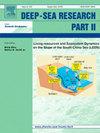The relative contribution of deep and shallow benthic sources to iron supply in the Ross sea, with specific emphasis on Ross Bank
IF 3
3区 地球科学
Q2 OCEANOGRAPHY
Deep-sea Research Part Ii-topical Studies in Oceanography
Pub Date : 2025-02-01
DOI:10.1016/j.dsr2.2024.105450
引用次数: 0
Abstract
Summer primary productivity in the Ross Sea is limited by the availability of dissolved iron (DFe) in the euphotic zone. Previous studies have suggested that benthic sources dominate the supply of DFe to the upper water column in the southern Ross Sea polynya. The purpose of this study is to investigate whether these benthic sources are derived from shallow banks or deeper areas of the continental shelf. Our study combines analysis of in situ observations near Ross Bank with a physical ocean model simulation in an overlapping summertime period to investigate the vertical supply of DFe. Two passive tracer dyes were employed in the ocean model with the first (second) being input in the bottom model layer over seabed depths of less (greater) than 400 m. The tracer dyes provide temporal (March 2011–January 2012) and spatial estimates of the advection, mixing and diffusion throughout the Ross Sea model domain, and enable estimates of the relative contributions of shallow and deep benthic iron sources to the upper ocean DFe inventory. A comparison of the model output with a ship-based survey and a mooring deployed on Ross Bank in January 2012 provides confidence that the model simulations produce a sufficiently accurate representation of ocean conditions to support estimates of benthic DFe supply to surface waters. The results demonstrate that for Ross Bank the local (on-bank) benthic supply is important during the early winter period, whereas for most of the year the deep (off-bank) benthic iron is the predominant source supplying the upper ocean over this shallow region.
深底和浅底生物资源对罗斯海铁供应的相对贡献,特别强调罗斯浅滩
罗斯海的夏季初级生产力受到光带中溶解铁(DFe)可用性的限制。以前的研究表明,底栖生物来源主导了南罗斯海冰湖上层水柱的DFe供应。本研究的目的是调查这些底栖生物来源是来自浅滩还是大陆架的较深区域。我们的研究结合了罗斯滩附近的现场观测分析和重叠夏季的物理海洋模式模拟,以调查DFe的垂直供应。在海洋模型中使用了两种被动示踪染料,第一种(第二种)在海床深度小于(大于)400米的模型底层输入。示踪染料提供了整个罗斯海模式域中平流、混合和扩散的时间(2011年3月- 2012年1月)和空间估计,并能够估计浅层和深层底底铁源对上层海洋DFe储量的相对贡献。将模型输出与2012年1月在罗斯滩进行的船舶调查和系泊进行的比较,可以确信,模型模拟能够充分准确地反映海洋状况,从而支持对底栖生物向地表水供应DFe的估计。结果表明,对罗斯浅滩来说,当地(岸内)底栖铁供应在初冬期间是重要的,而在一年中的大部分时间里,深海(岸外)底栖铁是供应浅水区域上层海洋的主要来源。
本文章由计算机程序翻译,如有差异,请以英文原文为准。
求助全文
约1分钟内获得全文
求助全文
来源期刊
CiteScore
6.40
自引率
16.70%
发文量
115
审稿时长
3 months
期刊介绍:
Deep-Sea Research Part II: Topical Studies in Oceanography publishes topical issues from the many international and interdisciplinary projects which are undertaken in oceanography. Besides these special issues from projects, the journal publishes collections of papers presented at conferences. The special issues regularly have electronic annexes of non-text material (numerical data, images, images, video, etc.) which are published with the special issues in ScienceDirect. Deep-Sea Research Part II was split off as a separate journal devoted to topical issues in 1993. Its companion journal Deep-Sea Research Part I: Oceanographic Research Papers, publishes the regular research papers in this area.

 求助内容:
求助内容: 应助结果提醒方式:
应助结果提醒方式:


